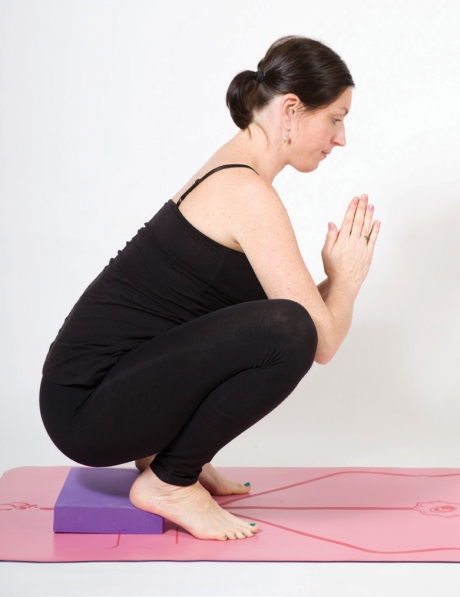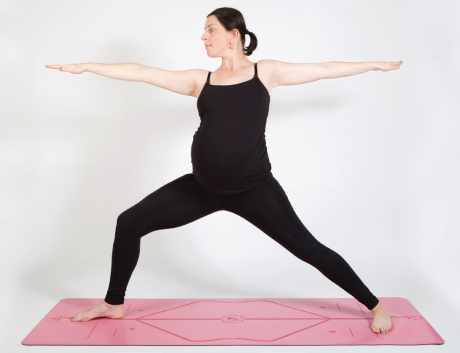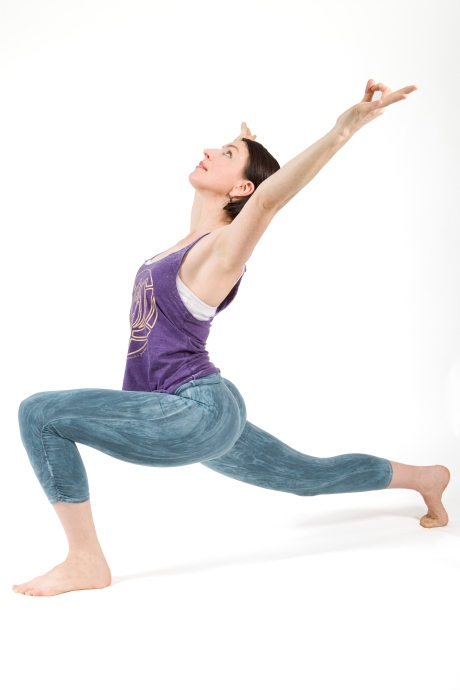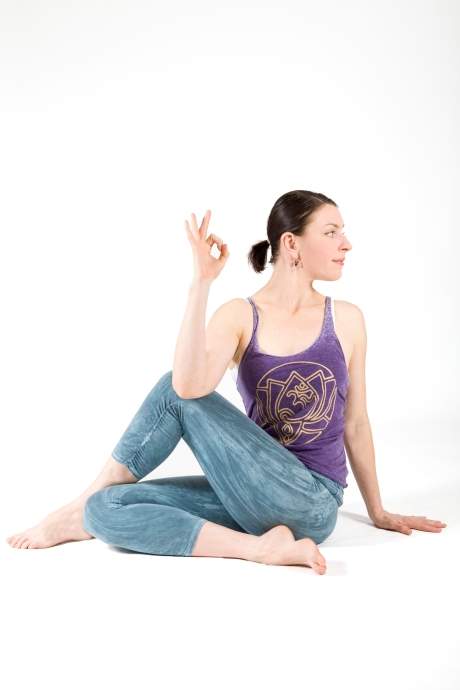As we know there are many benefits to yoga and practising yoga during pregnancy helps with many pregnancy related issues. Common conditions include lower back ache, fatigue, disturbed sleep and slower than normal digestion. With the right asana and pranayama practice however these issues can be much improved and help the mother enjoy her pregnancy and have the energy to focus on bonding with her baby.
It is best to rest as much as possible during the first trimester and so the following sequences should be practised during the second and third trimester only. As with any yoga practice, slow deep breathing is paramount, and even more so during pregnancy. If breathing becomes shallow or irregular during the yoga practice, slow right down and come back to your ‘centre’, just stop and breathe for a few moments. And then continue when you feel ready. Remember pregnancy is not a time to progress your practice, it is a time to slow down and be present, and accept the changes that are happening to you and your baby. Accepting change is a yoga practice in itself and one that should not be underestimated, so be present and enjoy this special time.
Pregnancy Yoga Sequence 1: Sun Salute
1 TADASANA: MOUNTAIN POSE
Stand in Tadasana (Mountain Pose) with the feet hip-width distance apart and the knees a little bent with the pelvis tucked under very slightly. Bring the hands into prayer position with the chin parallel to the floor and the face and shoulders relaxed. Press down firmly though the feet to create a sense of grounding and connection to the earth. Breathe slowly and deeply.
Now separate the hands and reach them out to either side before reaching them up over the head. Bring the hands together and draw them down through the heart centre in a prayer position as you exhale. Repeat three times.


2 HINDI SQUAT: LOW SQUAT
After the third repetition keep the hands in prayer position and slowly lower the body down into a low squat as you exhale. Pause for two or three breaths. The hands can be in prayer position or on the ground in front of the hips for additional support. Keep the spine as upright as possible and try to feel a sense of grounding through the feet. Engage the pelvic floor and feel the lower abdominals (Transverse Abdominus) draw in for additional support. If the heels lift from the floor during this squat place yoga blocks or similar under the heels. This will help to minimise any stress on the knee joint and help your balance.

3 SWOOPING CAT
From the Low Squat position, place the hands on the floor in front of the feet and move them forwards whilst moving into a box position. Now inhale and bend the elbows so they point back towards the legs (this will help to engage the triceps) and swoop forwards. Be mindful about the alignment of the back and avoid sinking in the lumbar spine. This will avoid pressure in the lower back area. As you move forwards the arms should feel as though they are working strongly. Now as you exhale press firmly into the hands to straighten the arms, arch the spine upwards and move the hips back towards the heels as in Balasana (Child Pose). Repeat this ‘swooping’ movement at least five times and maintain a sense of a flowing rhythm throughout by focusing on moving with the breath.




4 LOW SQUAT/HINDI SQUAT AND ROLL UP
Now move the hands back towards the knees and move into a low squat again. Pause and breathe before slowly coming up to standing. To do this press the feet firmly into the ground, and with the knees slightly bent, roll up slowly through the spine so the head comes up last. It should feel as though you are restacking the spine. The hands can be placed on the thighs for extra support for the lower back. Return to the start position; Tadasana with the feet hip width distance apart.


REPEAT THIS SUN SALUTATION AS MANY TIMES AS YOU WISH.
Sequence 2: Goddess Flow
1 WIDE LEG STANCE
From Tadasana with the feet hip-width distance apart, step the feet out wide (at least a meter distance apart) with the toes pointing outwards. Exhale and bend the knees whilst pressing firmly into the feet so that you feel grounded. Now interlace the fingers and reach the arms up towards the sky with the palms of the hands facing upwards. You should feel a stretch through the whole of the upper body. The pelvis is just slightly tucked under to help elongate the sacrum area but not so much that balance is compromised.

2 UTKATA KONASANA / GODDESS POSE
Now lower the pelvis a little more deeply by bending the knees more so the legs start to work more strongly in a wide squat position. Keep pressing firmly into the feet to encourage a sense of stability and ensure the knees are aligned over the ankles. Maintain an even breathing pattern throughout. Now reach the arms out to either side and lift the drishti a little. Keep the feeling of strength through the legs and length through the spine, gently contract the abdominal muscles so it feels like the core muscles are hugging your baby into towards the spine. Remain here for five breaths.

3 GODDESS POSE WITH SIDE BEND
Now lightly rest the right forearm onto the right thigh and reach the left arm up and over until the spine is in a lateral flexion (side bend) position and lift the drishti upwards. Maintain a sense of lifting through the upper body by avoiding putting too much weight through the right arm. The stretch should be felt on the left side of the rib cage. Hold for three to five breaths.

4 VIRABHADRASANA II / WARROR II
Slowly bring the upper body back to centre and straighten the legs so you can set the feet for Virabhadrasana II. Turn the right foot out and the left foot in around 45-degrees. Reach the arms out so they are parallel to the floor and bend the right knee deeply. Again press firmly through the feet and really lengthen through the arms. Hold for three to five breaths.

5 TRIKONASANA / TRIANGLE POSE
Now slowly straighten both legs and extend the upper body towards the right. Lightly rest the right hand onto the right shin and extend the left arm up towards the sky. There should be no pressure in the lower back. If there is discomfort through the lumbar spine area then bend the right knee slightly so the right leg offers more support. Rest the drishti to whereever is comfortable for the neck. Hold for three to five breaths.

6 GODDESS POSE
Now bring the upper body back to the centre and whilst the legs are straight turn the feet out ready for Goddess Pose again. Bend the knees and extend the arms gently out to either side with the elbows a little bent. Draw the shoulder blades down away from the ears and pause for one or two breaths. The legs should feel fatigued at this point so straighten them and lower the arms for several breaths to recover.

7 Once your legs have recovered, come back to Goddess Pose before moving into Goddess Pose with a side bend, Virabhadrasana II and Trikonasana on the left side. Move slowly and with awareness throughout and really focus on connecting with the breath, using Ujjayi pranayama if you can. From Trikonasana come back to Goddess Pose before straightening the legs and gradually bringing the feet back towards one another. Relax the arms by your side and take five deep, slow breaths to recover and help the heart rate return back to normal. Move into relaxation when you are ready.



As featured in the May issue of Yoga Magazine www.yogamagazine.co.uk
SALLY PARKES
SALLY, BSC, IS REGISTERED AS A SENIOR YOGA TEACHER WITH THE YOGA ALLIANCE UK, AND IS THE FOUNDER OF LAXMI YOGA TEACHER TRAINING SCHOOL WHICH OFFERS HATHA, VINYASA FLOW AND PREGNANCY YOGA TEACHER TRAINING COURSES. SHE ALSO RUNS RETREATS, IS A HEALTH AND FITNESS WRITER, AND TEACHES PRE AND POST-NATAL YOGA FOR ONLINE YOGA CHANNEL MOVEMENTFORMODERNLIFE.COM. FOR MORE INFORMATION, VISIT SALLYPARKESYOGA.COM
PHOTOGRAPHY: ALIWPHOTOGRAPHY.CO.UK













































